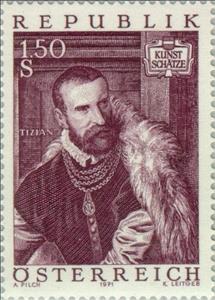Stamp: "Jacopo de Strada" by Tizian (c. 1488-1576) (Austria 1971)
"Jacopo de Strada" by Tizian (c. 1488-1576) (Austria 1971)
06 May (Austria ) within release Art Objects goes into circulation Stamp "Jacopo de Strada" by Tizian (c. 1488-1576) face value 1.50 Austrian schilling
| Stamp "Jacopo de Strada" by Tizian (c. 1488-1576) in catalogues | |
|---|---|
| Michel: | Mi:AT 1360 |
| Yvert et Tellier: | Yt:AT 1189 |
Stamp is vertical format.
Also in the issue Art Objects:
- Stamp - "Jacopo de Strada" by Tizian (c. 1488-1576) face value 1.50;
- Stamp - "Farmers Dance" by Pieter Breugel the Elder (c. 1525-1569) face value 2;
- Stamp - "Venice Girl" by Albrecht Dürer (1471-1528) face value 3.50;
Stamp "Jacopo de Strada" by Tizian (c. 1488-1576) it reflects the thematic directions:
Painting is the practice of applying paint, pigment, color or other medium to a solid surface (support base). The medium is commonly applied to the base with a brush, but other implements, such as knives, sponges, and airbrushes, can be used. Painting is a mode of creative expression, and the forms are numerous. Drawing, gesture (as in gestural painting), composition, narration (as in narrative art), or abstraction (as in abstract art), among other aesthetic modes, may serve to manifest the expressive and conceptual intention of the practitioner. Paintings can be naturalistic and representational (as in a still life or landscape painting), photographic, abstract, narrative, symbolistic (as in Symbolist art), emotive (as in Expressionism), or political in nature (as in Artivism). A portion of the history of painting in both Eastern and Western art is dominated by spiritual motifs and ideas. Examples of this kind of painting range from artwork depicting mythological figures on pottery, to Biblical scenes rendered on the interior walls and ceiling of the Sistine Chapel, to scenes from the life of Buddha or other images of Eastern religious origin. In art, the term painting describes both the act and the result of the action. The support for paintings includes such surfaces as walls, paper, canvas, wood, glass, lacquer, clay, leaf, copper and concrete, and the painting may incorporate multiple other materials including sand, clay, paper, plaster, gold leaf, as well as objects. The term painting is also used outside of art as a common trade among craftsmen and builders.
An invention is a unique or novel device, method, composition, idea, or process. An invention may be an improvement upon a machine, product, or process for increasing efficiency or lowering cost. It may also be an entirely new concept. If an idea is unique enough either as a stand-alone invention or as a significant improvement over the work of others, it can be patented. A patent, if granted, gives the inventor a proprietary interest in the patent over a specific period of time, which can be licensed for financial gain.
An architect is a person who plans, designs, and oversees the construction of buildings. To practice architecture means to provide services in connection with the design of buildings and the space within the site surrounding the buildings that have human occupancy or use as their principal purpose. Etymologically, the term architect derives from the Latin architectus, which derives from the Greek (arkhi-, chief + tekton, builder), i.e., chief builder
Painting is a visual art, which is characterized by the practice of applying paint, pigment, color or other medium to a solid surface The medium is commonly applied to the base with a brush, but other implements, such as knives, sponges, and airbrushes, may be used. One who produces paintings is called a painter.
Linguistics is the scientific study of language.The areas of linguistic analysis are syntax (rules governing the structure of sentences), semantics (meaning), morphology (structure of words), phonetics (speech sounds and equivalent gestures in sign languages), phonology (the abstract sound system of a particular language, and analogous systems of sign languages), and pragmatics (how the context of use contributes to meaning). Subdisciplines such as biolinguistics (the study of the biological variables and evolution of language) and psycholinguistics (the study of psychological factors in human language) bridge many of these divisions




